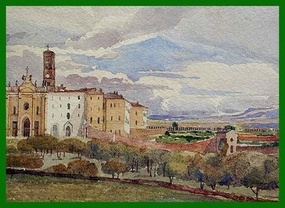Rejoice, O Jerusalem: and come together all you that love her: rejoice with joy you that have been in sorrow: that you may exult, and be filled from the breasts of your consolation.
Lætáre Jerúsalem :et convéntum fáciteómnes qui dilígitis éam: gaudéte cum lætítia, qui in tristítia fuístis: ut exsultétis, et satiémini abubéribus consolatiónis véstræ.
Psalm verse: I rejoiced at the things that were said to me: we shall go into the house of the Lord.
Lætátus sum in his quæ dícta sunt míhi: in dómum Dómini íbimus.

The Mass prayers and Divine Office for today was written particularly for Laetare Sunday and for the Roman Basilica of Santa Croce in Gerusalemme (Holy Cross in Jerusalem). You can go to Jerusalem without having to leave Rome when you visit this basilica! I had the great joy of spending a month with the Cistercian monks of Santa Croce in 2007 and celebrating today's feast with them. The monks pastorally administer the basilica which contain the relics of the Holy Passion of Lord and the mortal of remains of the Servant of God, Nenolina Melo.
In her marvelous work, The Mass Through the Year, Sister Aemiliana says of the Church's observance today: "Today, the glory of the resurrection is made present out of time, and in a single word all of the splendor of the foreplay for the feast of Easter is gathered. . . . Jerusalem! Sion! It is to Jerusalem that the call goes out. Jerusalem is the shining reason for this joy. Jerusalem, the holy city" (243).
One can't forget of the grace indicated by today's gospel from Saint John: the light of the world is given to the man whose eyes are blind. Literally and spiritually sight is restored to the blind. The miracle of sight is such that the man is cured and healed: eyes see light and his soul sees the face of the Lord.+If you want to know the liturgical theology of a given day in the Church year look at the antiphons. For Laetare Sunday the Communion Antiphon reveals to us the mystery at hand: "The Lord made clay of spittle, and spread it on my eyes: and I went, and washed, and recovered my sight, and I found faith in God" (Jn 9:11). Sister Aemiliana tells us that "we come to the sacred liturgy, carrying our human blindness, sometimes the blindness of sin, to the altar. We come to the Savior's hands, to the pool of Siloe; and what takes place?" (The Mass Through the Year, 263).

Note, too, that holy Mother the Church puts these sentiments in our hearts as we approach the the Holy Mountain where the Mystery of our Faith is given, Holy Communion. Religiously I pray prior to receiving Holy Communion the prayer composed by Saint Thomas Aquinas where he speaks of human frailty as weak before the power of Christ, where humanity --my own humanity-- is blind to the mystery of Christ's Body and Blood, Soul and Divinity. The line in Aquinas' prayer striking: "I come to it as a blind man to the radiance of eternal light" (Prayer Before Mass, Roman Missal). Moreover, the antiphon at the time of our reception of Holy Communion today describes in the words of the man born blind: "The mysterious pool of Siloe is represented by the chalice, with its precious water and blood from the wound in the side of the Crucified. Everything is ready for healing and illumination" (The Mass Through the Year, 263).
Laetare Sunday is indeed a day of rejoicing --and we see this in the rose vestments worn by the clergy-- in the light of future glory promised by God and the Prophets where my inability to see, my lack of understanding, and my stubbornness of not knowing and accepting ground of being, Christ, are overturned.


Leave a comment